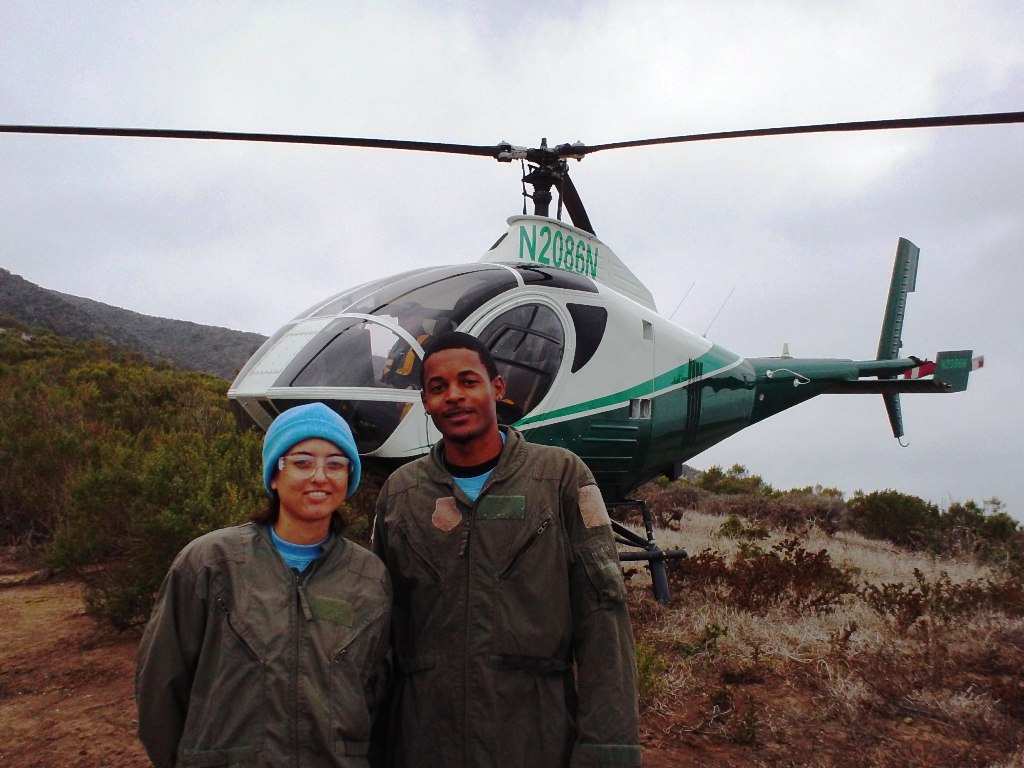
What do helicopters, paintball guns, and inner city youth have to do with invasive plant removal? A lot actually. Corps often engage in projects to fight the advance of non-native species in our parks and forests, but Corpsmembers involved in Los Angeles Conservation Corps’s Flying Weed Warriors project quite literally went to battle against invasive plants.
Invasive plant removal usually involves Corpsmembers trekking through forests to cut down or pull out the offending species. What makes the Flying Weed Warriors project different is that they used a cutting-edge land management technique known as Herbicide Ballistic Technology (HBT). HBT involves shooting paintballs filled with high concentrations of herbicide from modified paintball guns. Shooting the guns from a helicopter enables all infestations to be accessed and treated quickly. Using the helicopter also provided an ideal vantage point to detect any new invasive species. Corpsmembers with the Flying Weed Warriors project used HBT to treat over 100 pampas grass infestations on Santa Cruz Island – the largest and most biologically diverse of California’s eight Channel Islands.
Flying Weed Warriors was made possible through the collaborative efforts of the Los Angeles Conservation Corps, The Nature Conservancy Santa Cruz Island Preserve, the University of Hawaii, Native Range, Inc., and the generous support of the JiJi foundation. In addition to successfully helping stop the spread of a harmful species in one of America’s most environmentally unique areas, the partnerships of the Flying Weed Warriors project connected a wide range of people who otherwise would have never met.
“Although the project’s focus was research based conservation, it also helped bridge educational and socio-economic gaps between participants, leading to friendships and mentorships that would be unlikely without this unique collaboration” said Dan Knapp, Los Angeles Conservation Corps’ Deputy Director. “For this particular project, Corpsmembers were not just a labor force or mechanism for successful conservation work; they were members of a cutting edge research team.”

In many ways, the Flying Weed Warriors project was an eye-opening experience for the Corpsmembers involved. Before the project, none of the Corpsmembers had ever been to the Channel Islands, ridden on a boat, or flown in a helicopter. During their down time, Corpsmembers went snorkeling and explored the island – a place that has many endemic (and endangered) plant and animal species. The project was also an eye-opener for the researchers involved. Corpsmembers and researchers, including Dr. James Leary from University of Hawaii and Dr. Guy Keiser from University of California Davis, all lived together for up to four days at a time. This allowed members of the academic community to engage and teach members of a historically disenfranchised population.
Corpsmembers involved in Flying Weed Warriors participated in important research that supports efforts to get the use of HBT permitted throughout California. One of the project partners, Native Range, Inc., is now eager to hire Corpsmember participants once they receive State Herbicide application licenses. Native Range has even offered to help with preparation for the state licensing test.
In addition to gaining exposure to new places, new ideas, and new kinds of people, Corpsmembers in the Flying Weed Warriors project simply had a lot of fun. After all, what’s not to like about flying around in helicopters with paintball guns in the name of science?





































































